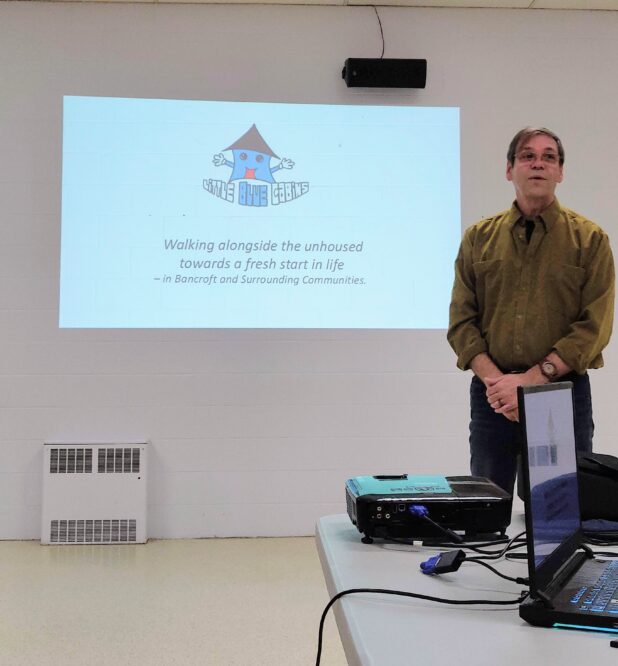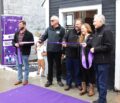Headline News
Little Blue Cabins seeks feedback at stakeholder meeting
September 26, 2023

By Bill Kilpatrick
On Sept. 20 from 8 a.m. to 10 a.m. Kevin Taylor, chair of the board for Little Blue Cabins, along with the other board members, held a stakeholder meeting at the Faraday Community Centre. The purpose of the meeting according to Taylor was to “discuss their business plan and their logic model and to seek feedback and ideas from those present.”
The meeting was attended by over 20 different stakeholders from multiple agencies throughout Bancroft and Hastings County, including members of the Canadian Mental Health Association, Hastings County Community and Human Services, members of Bancroft municipal council, Community Futures Development Corporation, staff members from surrounding municipalities, health care providers, and many concerned citizens who are looking to contribute to the project.
Taylor began by pointing out that this stakeholders’ meeting was not an information session about the Little Blue Cabin project; and that for those who want more information they could access the webpage, www.littlebluecabins.ca, where they can find information on the history of the project and much of the finer details. Taylor also wanted to clear up some misinformation that was circulating.
“There’s been some misconceptions going around,” said Taylor adding that, “This [project] is not intended to take everybody who is living in the encampments and put them inside of the cabins. This is not just a housing initiative or emergency housing. That still needs to be done. There still needs to be emergency shelters, but that has nothing to do with Little Blue Cabins; other than it might be a launching pad for somebody living in the emergency shelter to be accepted through an intake into the Little Blue Cabins.”
Taylor also wanted to clarify that the Little Blue Cabins are not long-term housing. The cabins are intended to house people for three months to three years, “This is the middle,” says Taylor, “this is the part that stops the cycle from continually happening. This is where we help people and it could take years.”
Taylor also wanted to address some other frequently asked questions such as: Does a person need to be clean [of drugs] to get into the Little Blue Cabins? “Absolutely not,” stated Taylor, “but they need to be on a road towards that though.”
Ideally Taylor would like those who are in the cabins to be working toward the same goals of job training, education and moving towards long-term housing, but, adds Taylor, if someone does need rehabilitation those assisting with the Little Blue Cabins will be in a position to help facilitate that as well. Taylor went on to point out that there are rehabilitation programs that require people to have an address before they can get into a facility adding that they will also have a place to go when they get out of rehabilitation, “That’s really important [for long term success]” says Taylor.
Another frequently asked question Taylor gets all the time is: How much does it cost? Taylor estimates that the national average to house someone who is unhoused is $14,000 to $16,000 per year, whereas to not house them costs between $45,000 to $60,000 per year. The cost to house someone at the Little Blue Cabins, according to the statistics provided is estimated at $21,000 to $24,000 per year. “As taxpayers,” states Taylor, “It’s pretty important that we realize that there are substantial savings to all of us to help house folks instead of leaving them on the street.”
After addressing the misinformation and the frequently asked questions Taylor wanted to directly address the homelessness situation in general. He pointed that the current statistics on those who are unhoused show just how complicated the problem really is, “We do have to get it out of our minds that everybody is addicted to something or that everyone has a mental illness, that’s not what the statistics show,” say Taylor. The statistics that he provided from The Homeless Hub and www.infrastructure.gc.ca paint a picture of a multifaceted issue that has many layers that include mental illness and addiction, but also unemployment and chronic homelessness. According to the slide show, 30 to 35 per cent of those experiencing homelessness have mental illnesses, but that number increases to 75 per cent for women. In terms of addiction or substance use more than 35 per cent report that their use of substances was their main reason for becoming unhoused, an issue that is often exacerbated when they become homeless.
As stated in the slide show, some 15 per cent of those who are homeless are chronically homeless whereas the vast majority of those who are homeless are episodic or transitionally homeless. In terms of unemployment, Taylor’s statistics point out that only 20 to 25 per cent of Canada’s homeless are employed. Taylor admits that housing first is important, but adds that in order to address the complicated issue of housing there needs to be what he calls, “wrap-around community care and support.”
For Taylor the key to the success of housing people and preventing future homelessness is the community hub model. “[Just] putting up cabins does not work,” says Taylor, “There’s no stability, there’s no dignity for the people that live there and there’s certainly is no walk-along-side approach [that the community hub and the wrap-around care model provides.]” A community hub, as outlined in the slide show, provides a central place for all the residents to cook, shower, do laundry, access computers, dine, and have a common living space. The wrap-around care model means that those who are housed have access to individualized support services, from medical care to social services, social and employment services, as well as 24/7 professional staff with lived experience and caring volunteers all within the community hub.
The Vice-chair of the Little Blue Cabins board of directors, Ken Balmer, spoke about the logic model that the project is adopting. The model will be focused on results and outcomes, but as Balmer explains these really mean nothing unless there is actual change in the individuals. Balmer pointed out that the number of intakes or the number of counselling hours means nothing unless these result in tangible changes.
“The beauty of this approach,” explains Balmer, “Is that some results are immediate. When someone is welcomed into this community they immediately have personal safety and security for themselves and their belongings and they have hope because they are in a community that is all aspiring toward the same recovery. They have access to services that they did not have access to before; now the services come to them [and] all of that happens immediately.”
Once these basic supports are in place says Balmer then the services become more individualized and focus specifically on achieving outcomes such as stable, sustainable housing, and/or sustained recovery of addiction behaviours, and/or optimal mental health and wellbeing and/or meaningful, sustainable employment. For example, if an individual is working towards optimizing their mental health and wellbeing, the logic model, as outlined in the power point presentation, states that once the basic supports are in place for the individual they would then begin working on achieving successful first steps, such as nutrition and personal hygiene, coping skills, using community supports, and addressing poor health determinants. Once those basic steps have been taken, the individual would then work on sustaining those achievements on their way to achieving their optimal mental health and wellbeing. The end goal, according to the logic model, is to achieve healthier individuals which will ultimately result in healthier communities, and reduced social, health and justice costs.
Now that the Little Blue Cabin project has completed phase one or the foundation phase of their development plan, they are looking to begin phase two or what they call the preparation stage. Phase one involved research into best practices, designing a proposal concept, a webpage, incorporation, board recruitment and development, insurance enquiries, a risk management plan, and a business plan, which have been completed. Now, what they need is the land to put the cabins on in order to move into phase two. Taylor says that he is encouraging local municipalities to put pressure on the upper levels of government, mainly the County of Hastings and the province, to step up and help acquire the land needed to move this project ahead.
While a tentative budget has been created there are still any number of unknowns that will only be known when the land is acquired, says Taylor. Some unknowns are whether or not there will be a hydro hook up, whether the land will require a drilled well and a septic system and how building codes may impact the price. Taylor remains optimistic that they will secure the required land in the not-too-distant future and once that is achieved things will move very quickly. Taylor pointed out that some of the planning for phases three and four, development and operation, have already been completed, all they need now to move ahead is the land.
“This is not a Bancroft problem,” said Bancroft Mayor Paul Jenkins, “This is a regional problem [and] we have to get everybody involved [if we want this to succeed].”
As Balmer discussed the business plan template, he pointed out that it was a fairly simple plan to grasp, but he also recognized that they do not have all the answers and need constructive feedback from both the professionals and the homeless population as well for this project to succeed. He finished his presentation with an ask of the stakeholders, which could be extended to the upper levels of government and the community at large, he said, “Help us get it right.” As Taylor said, “We’ve been talking about this for a long time, now it’s time to do something.”
Those interested in helping the Little Blue Cabin project can go to www.littlebluecabins.ca or call 613-334-0409.


















